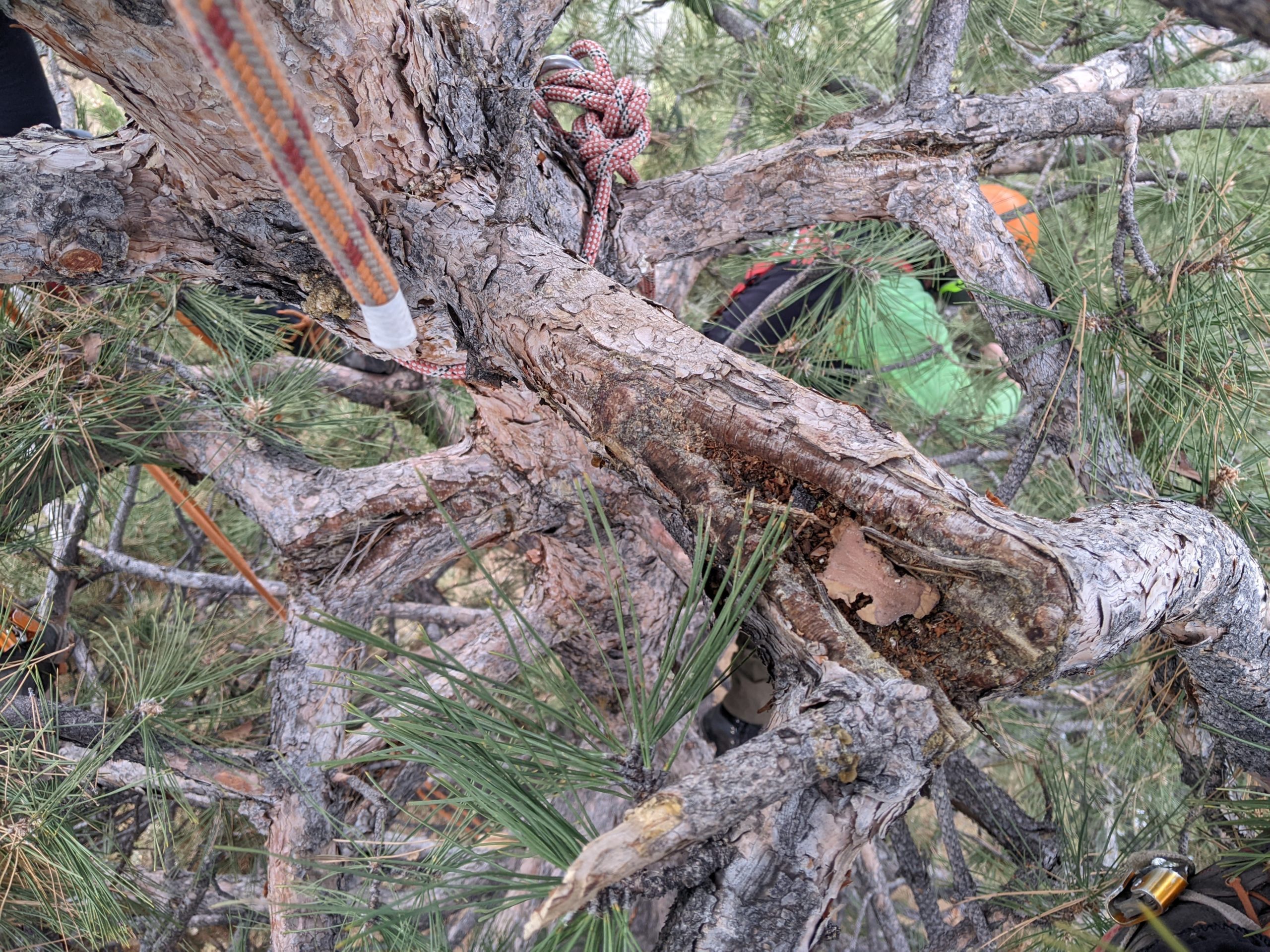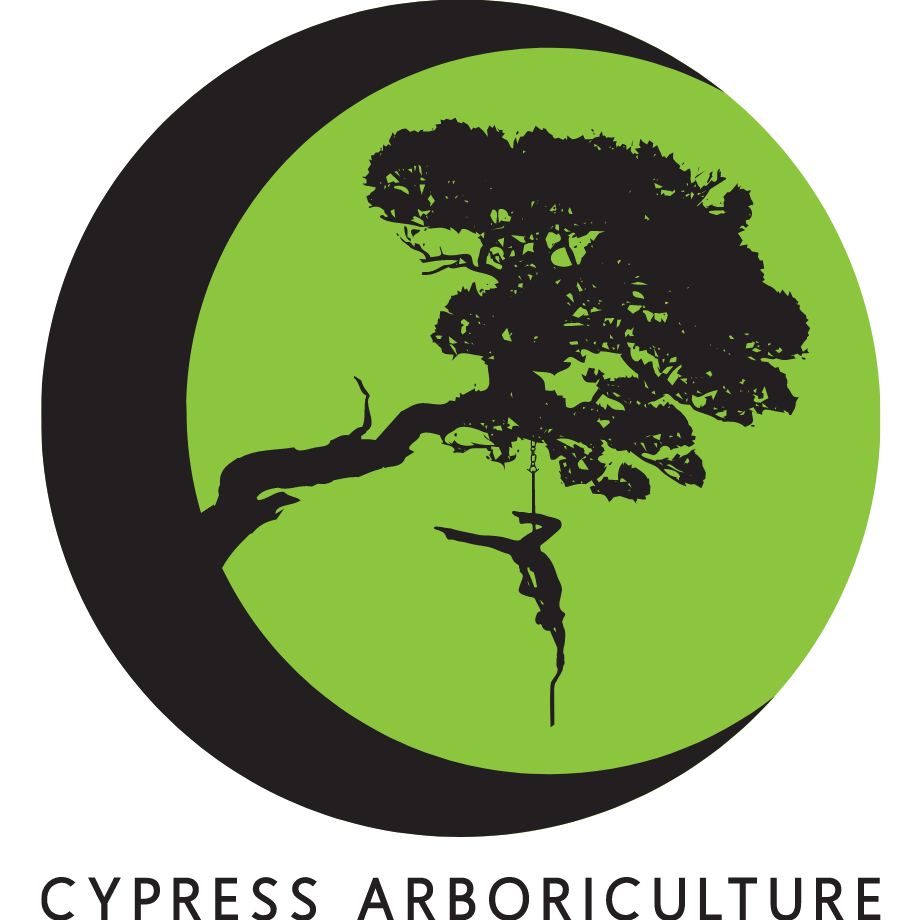There is a trend in tree work to default to the most conservative answer when it comes to risk. We decide whether a tree should live or die based on the assumption that any defect makes the tree unsound and that makes it likely to cause major damage to life and property. This attitude may be motivated by the desire to stay out of court, by the desire to win more lucrative removal contracts or by genuine concern for public safety. But extend this attitude to its logical conclusion and we’re left with a short, bleak urban canopy.

Let me back up…
This April, I got an email through my website seeking a second opinion. A neighborhood tree company had been knocking on doors and had insisted that a large, mature tree in Lakewood needed to be removed. The solicitor misidentified the Hackberry (Celtis occidentalis) as a Silver Maple (Acer saccharinum), but he did spot the massive section of decay in the lower trunk and marked it as a point of concern.
When I arrived on the property, two things were immediately clear. First, the tree was indeed at risk of partial failure. Second, the tree was a focal point of the property. It was the client’s pride and had been a major reason for the purchase of the home! Despite the split in the stem from an old lighting strike slowly creaking in the spring wind, I knew I needed to find a way to keep the Hackberry around for a few more years if I could. I spent more than an hour pacing beneath that ponderous canopy, sucking air through my teeth and trying to picture the physics at work. Here was an overextended canopy over the home. There was an 8″ wound more than 10 years old where someone had removed a central leader. Here was a branch base beginning to buckle with the forces being exerted on its calloused, partially-decayed stem attachment.
But I also saw very encouraging signs. While the cavity and splitting were considerable, there was ample sound wood and callous holding things together. The tree had begun leafing out right on time for a Hackberry and was producing vigorous shoots throughout its crown, indicating that the tree’s overall health was good.
The principal problem was the split where one of the major leaders attached to the main stem. The leader in danger of failing extended over the driveway and partially overhung the neighbor’s yard. By looking at the angles in question, I felt it would be possible to shorten the branch so that, in the event of failure, any damage to the neighbor’s property would be minimized. At the same time, careful shortening of the limb would lessen the leverage acting on the weak section of trunk, lessening the likelihood of failure. Of course, the client would still be wise not to park underneath the leader – this much would have to me made clear. As we were entering the windy fall season, when the risk of a late snow was very real, I felt the tree needed an IMMEDIATE lightening of leverage. We scheduled a three hour emergency pruning session and inspection, which revealed further interesting defects, but solidified my resolve that the tree could be retained. Once aloft, I could tell that the tree still had sufficient strength to cope with wind and snow for a while.
The decay in the base of the tree was my second major concern. While there was a disconcertingly large open wound, there was also a healthy column of cambium feeding every major leader coming from the stem. The vigor of the above-ground shoots made me confident that the roots underground were still working efficiently and the tree hadn’t yet given up. There were two other very extended leaders – one over the lawn and one over the entry to the home – which would need to be lightened considerably at the tips if the tree was to be kept.
I looked up into the Hackberry, thinking of caveat after caveat: “The tree looks very vigorous now, but it could begin to decline this year or next. I can make cuts to lighten the loads I see over both homes, but it’s impossible to “engineer” a tree, and it still has the potential to fail due to visible or invisible defects. I can prune heavily in selective places in order to make limbs more structurally sound, but it is difficult to say how the tree will react – will it send up weak sucker growth to compensate, cut its losses by compartmentalizing and discard entire branches or send energy to the remaining strong limbs?”
This is the nature of the work. Educated arborists endeavor to treat patients in the best way they can. We make care decisions based on experience with other trees, on knowledge garnered at conferences, in publications and in conversations with colleagues. But it is also the nature of the work to navigate with a fair amount of uncertainty. Trees cannot communicate their symptoms or needs clearly. In the litigious environment we inhabit, it makes sense that arborists might default to the “safest” answer and remove anything remotely threatening, but what values are we sacrificing by doing so? If this tree had been over a busy street or in the middle of a public park, the exposure would have made the decision much clearer. With near constant human presence underneath the tree, it’s unreasonable to keep such a tree standing without building some kind of barrier to protect public safety. In this case, while the tree does threaten a structure, it’s the owner’s perogative to accept their level of risk once they have been fully informed by an expert in the field.
So it came to a difficult conversation with the homeowner; here was a tree I felt confident could provide considerable benefit into the future. How far into the future, however, was certainly a question.
These are the jobs that make life as an Arborist worthwhile.
I spent a few days pondering the tree, losing sleep and picturing all the angles of the Hackberry’s canopy. I finally sent the client two bids; one for removal and one for a relatively heavy-handed structural pruning intended to keep the tree from failing until it had actively begun to decline. Along with the bids, I wrote an extensive email detailing all the scenarios, the risks and the costs associated with keeping the tree: I recommended a yearly inspection regimen and some upgrades to overall care, and highlighted the fact that there was little money being saved, since the tree’s eventual removal was likely to cost just as much as it would if it was done now. In addition to the “hospice care” costs, I discussed the less tangible benefits of preservation: It was still a contributing member of the mature canopy in the neighborhood, was still quite strong and vigorous (by no means on its last legs), and it was shading the house, which would keep things much more comfortable in the approaching heat of summer. Few of these benefits have price-tags attached, but from a quality of life perspective, they are priceless.
Thankfully, they elected to keep it around.
Even in the worst-case “staged removal” scenario, where we remove larger pieces as time progresses, the less tangible benefits of maintaining the Hackberry on hospice care were enough to outweigh the costs.
Mature trees are conflicting creatures in the urban canopy. They overhang structures, lift sidewalks and send roots into sewer pipes. They require expensive maintenance pruning to keep in good health, sometimes need costly plant-health-care treatments to battle fungal and insect invaders, and even a trained arborist is hard-pressed to give any sort of guarantee on their longevity. But imagine for a moment a perfectly “safe” canopy – one where all risk has been mitigated away. It looks a lot like a canopy of short-statured trees growing away from people and homes. I don’t think it takes a person who works intimately with trees to see how distasteful that scene would be.
Preventing a risk-less, sun-blasted city, then, becomes a matter of advocating for the sometimes-dangerous, always interesting older tree. As an arborist, it’s that advocacy that makes me tick. I love to see the good ones taken care of and the not-so-good taken out of the way so that the canopy can grow fuller and stronger. It means being crystal-clear with clients on risks, benefits and future prospects, but I think it leads to a better-managed urban forest, more-pleasant neighborhoods and much happier trees!
Removal had its own benefits associated. Peace-of-mind and considerable cost savings over time were the largest. For my company, a removal would be a large, fast cash infusion at more than double the price of pruning, and I would never have to worry that my counsel had led a client to keep a potential hazard in their front yard. In many ways, removing the tree would have been the “easy way out.” Less stress for everyone.
Everyone except the tree.
